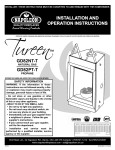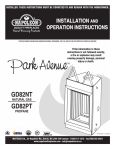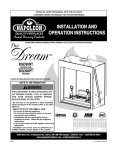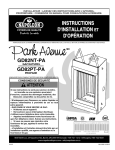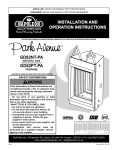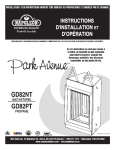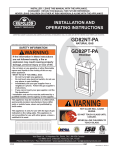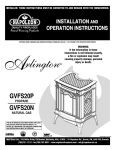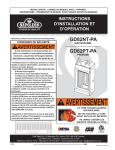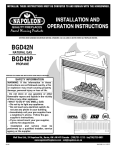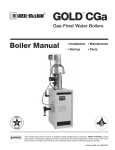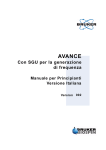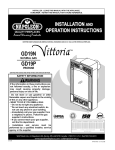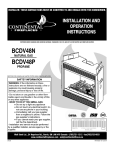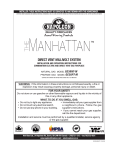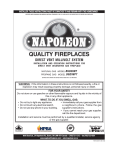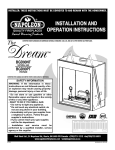Download Napoleon Fireplaces TUREEN GD82NT-T User's Manual
Transcript
1 INSTALLER: THESE INSTRUCTIONS MUST BE CONVEYED TO AND REMAIN WITH THE HOMEOWNER. INSTALLATION AND OPERATION INSTRUCTIONS CERTIFIED UNDER CANADIAN AND AMERICAN NATIONAL STANDARDS: CSA 2.33, ANSI Z21.88 FOR VENTED GAS FIREPLACE HEATERS. GD82NT-T NATURAL GAS GD82PT-T PROPANE CERTIFIED FOR CANADA AND UNITED STATES USING ANSI/CSA METHODS. SAFETY INFORMATION WARNING: If the information in these instructions are not followed exactly, a fire or explosion may result causing property damage, personal injury or loss of life. - Do not store or use gasoline or other flammable vapors and liquids in the vicinity of this or any other appliance. - WHAT TO DO IF YOU SMELL GAS: Do not try to light any appliance. Do not touch any electrical switch; do not use any phone in your building. Immediately call your gas supplier from a neighbour’s phone. Follow the gas supplier’s instructions. If you cannot reach your gas supplier, call the fire department. - Installation and service must be performed by a qualified installer, service agency or the supplier. Wolf Steel Ltd., 24 Napoleon Rd., Barrie, ON L4M 4Y8 Canada • (705)721-1212 • fax(705)722-6031 W415-0583 / B / 05.23.07 www.napoleonfireplaces.com • [email protected] $10.00 W415-0583 / B / 05.23.07 2 TABLE of CONTENTS PG 2-5 INTRODUCTION 19 Warranty Dimensions General Instructions General Information Care of Glass & Plated Parts 5-9 19-23 OPERATION / MAINTENANCE Time Out Fireplace Operation Hand Held Remote Operation Dip Switch Number Chart Operating Instructions VENTING Vent lengths Venting Specifications Air Terminal Locations 10-15 24 25 CONVERSION KIT 26-27 REPLACEMENTS Replacement Parts Flexible Vent Kits Terminal Kits Roof Terminal Kits Accessories Replacement Parts Diagram ELECTRICAL CONNECTION Hard Wiring Connections ADJUSTMENTS Pilot Burner Adjustment Venturi Adjustment INSTALLATION/FRAMING Wall & Ceiling Protection Using Flexible Vent Components Fireplace Vent Connection Using Rigid Vent Components Gas Installation Restricting Vertical Vents Framing Clearance to Combustibles Mantle Clearances and Enclosures 15 NIGHT LIGHTTM REPLACEMENT 28-29 TROUBLE SHOOTING GUIDE Schematic 16-18 FINISHING / SERVICING Door Removal Burner Assembly Removal Battery Replacement Blower Replacement Bowl, Mesh & Rock Replacement 30 31 SERVICE HISTORY NOTES PLEASE RETAIN THIS MANUAL FOR FUTURE REFERENCE WARNING • Do not burn wood or other materials in this fireplace. • Adults and especially children should be alerted to the hazards of high surface temperatures and should stay away to avoid burns or clothing ignition. Supervise young children when they are in the same room as the fireplace. • Clothing or other flammable material should not be placed on or near the fireplace. • Due to high temperatures, the fireplace should be located out of traffic and away from furniture and draperies. • Ensure you have incorporated adequate safety measure to protect infants/toddlers from touching hot surfaces. • Even after the fireplace is out, the glass and/or screen will remain hot for an extended period of time. • Check with your local hearth specialty dealer for safety screens and hearth guards to protect children from hot surfaces. These screens and guards must be fastened to the floor. • Any safety screen or guard removed for servicing must be replaced prior to operating the fireplace. • It is imperative that the control compartments, burners and circulating blower and its passageway in the fireplace and venting system are kept clean. The fireplace and its venting system should be inspected before use and at least annually by a qualified service person. More frequent cleaning may be required due to excessive lint from carpeting, bedding material, etc. The fireplace area must be kept clear and free from combustible materials, gasoline and other flammable vapours and liquids. • Under no circumstances should this fireplace be modified. • This fireplace must not be connected to a chimney flue pipe serving a separate solid fuel burning appliance. • Do not use this fireplace if any part has been under water. Immediately call a qualified service technician to inspect the fireplace and to replace any part of the control system and any gas control which has been under water. • Do not operate the fireplace with the glass door removed, cracked or broken. Replacement of the glass should be done by a licensed or qualified service person. • Do not strike or slam shut the fireplace glass door. • This fireplace uses and requires a fast acting thermocouple. Replace only with a fast acting thermocouple supplied by Wolf Steel Ltd. • Pressure relief doors must be kept closed while the fireplace is operating to prevent exhaust fumes containing carbon monoxide, from entering into the home. Temperatures of the exhaust escaping through these openings can also cause the surrounding combustible materials to overheat and catch fire. W415-0583 / B / 05.23.07 3 NAPOLEON® products are manufactured under the strict Standard of the world recognized ISO 9001 : 2000 Quality Assurance Certificate. NAPOLEON® products are designed with superior components and materials, assembled by trained craftsmen who take great pride in their work. The burner and valve assembly are leak and test-fired at a quality test station. The complete fireplace is thoroughly inspected by a qualified technician before packaging to ensure that you, the customer, receives the quality product that you expect from NAPOLEON®. NAPOLEON® GAS FIREPLACE PRESIDENT’S LIFETIME LIMITED WARRANTY The following materials and workmanship in your new Napoleon® gas fireplace are warranted against defects for as long as you own the fireplace. This covers: combustion chamber, heat exchanger, stainless steel burner, PHAZER™ logs and embers, ceramic glass (thermal breakage only), gold plated parts against tarnishing, porcelainized enamelled components and aluminum extrusion trims. Electrical (110V and millivolt) components and wearable parts such as the blower, gas valve, thermal switch, switches, wiring, remote control, ignitor, gasketing, and pilot assembly are covered and NAPOLEON® will provide replacement parts free of charge during the first year of the limited warranty. Light bulbs are not covered by this warranty. Labour related to warranty repair is covered free of charge during the first year. Repair work, however, requires the prior approval of an authorized company official. Labour costs to the account of NAPOLEON® are based on a predetermined rate schedule and any repair work must be done through an authorized NAPOLEON® dealer. CONDITIONS AND LIMITATIONS NAPOLEON® warrants its products against manufacturing defects to the original purchaser only -- i.e., the individual or legal entity (registered customer) whose name appears on the warranty registration card filed with NAPOLEON® -- provided that the purchase was made through an authorized NAPOLEON® dealer and is subject to the following conditions and limitations: This factory warranty is nontransferable and may not be extended whatsoever by any of our representatives. The gas fireplace must be installed by a licensed, authorized service technician or contractor. Installation must be done in accordance with the installation instructions included with the product and all local and national building and fire codes. This limited warranty does not cover damages caused by misuse, lack of maintenance, accident, alterations, abuse or neglect and parts installed from other manufacturers will nullify this warranty. This limited warranty further does not cover any scratches, dents, corrosion or discolouring caused by excessive heat, abrasive and chemical cleaners nor chipping on porcelain enamel parts, mechanical breakage of PHAZER™ logs and embers, nor any venting components used in the installation of the fireplace. NAPOLEON® warrants its stainless steel burners against defects in workmanship and material for life, subject to the following conditions: During the first 10 years NAPOLEON® will replace or repair the defective parts at our option free of charge. From 10 years to life, NAPOLEON® will provide replacement burners at 50% of the current retail price. In the first year only, this warranty extends to the repair or replacement of warranted parts which are defective in material or workmanship provided that the product has been operated in accordance with the operation instructions and under normal conditions. After the first year, with respect to this President’s Limited Lifetime Warranty, NAPOLEON® may, at its discretion, fully discharge all obligations with respect to this warranty by refunding to the original warranted purchaser the wholesale price of any warranted but defective part(s). After the first year, NAPOLEON® will not be responsible for installation, labour or any other costs or expenses related to the reinstallation of a warranted part, and such expenses are not covered by this warranty. Notwithstanding any provisions contained in this President’s Limited Lifetime Warranty, NAPOLEON®’S responsibility under this warranty is defined as above and it shall not in any event extend to any incidental, consequential or indirect damages. This warranty defines the obligations and liability of NAPOLEON® with respect to the NAPOLEON® gas fireplace and any other warranties expressed or implied with respect to this product, its components or accessories are excluded. NAPOLEON® neither assumes, nor authorizes any third party to assume, on its behalf, any other liabilities with respect to the sale of this product. NAPOLEON® will not be responsible for: over-firing, downdrafts, spillage caused by environmental conditions such as rooftops, buildings, nearby trees, hills, mountains, inadequate vents or ventilation, excessive venting configurations, insufficient makeup air, or negative air pressures which may or may not be caused by mechanical systems such as exhaust fans, furnaces, clothes dryers, etc. Any damages to fireplace, combustion chamber, heat exchanger, brass trim or other component due to water, weather damage, long periods of dampness, condensation, damaging chemicals or cleaners will not be the responsibility of NAPOLEON®. The bill of sale or copy will be required together with a serial number and a model number when making any warranty claims from your authorized dealer. The warranty registration card must be returned within fourteen days to register the warranty. NAPOLEON® reserves the right to have its representative inspect any product or part thereof prior to honouring any warranty claim. ALL SPECIFICATIONS AND DESIGNS ARE SUBJECT TO CHANGE WITHOUT PRIOR NOTICE DUE TO ON-GOING PRODUCT IMPROVEMENTS. NAPOLEON® IS A REGISTERED TRADEMARK OF WOLF STEEL LTD. PATENTS U.S. 5.303.693.801 - CAN. 2.073.411, 2.082.915. © WOLF STEEL LTD. W415-0583 / B / 05.23.07 4 FIGURE 1 58" 46" 17 3/4" 37 /8" 5 4" DIA. 7" DIA. 1 21" 22 /8" 5" 2" 24" 28" 7 8 7/8" GENERAL INSTRUCTIONS 13 7/8" /8" 14" 28" Under extreme vent configurations, allow several minutes (5-15) for the flame to stabilize after ignition. THIS GAS FIREPLACE SHOULD BE INSTALLED AND SERVICED BY A QUALIFIED INSTALLER to conform with local codes. Installation practices vary from region to region and it is important to know the specifics that apply to your area, for example: in Massachusetts State: Provide adequate ventilation and combustion air. • The fireplace damper must be removed or welded in the open position prior to installation of a fireplace insert or gas log. • The appliance off valve must be a “T” handle gas cock. • The flexible connector must not be longer than 36 inches. • The appliance is not approved for installation in a bedroom or bathroom unless the unit is a direct vent sealed combustion product. • A carbon monoxide detector is required in all rooms containing gas fired appliances. • WARNING: This product must be installed by a licensed plumber or gas fitter when installed within the commonwealth of Massachusetts. Objects placed in front of the fireplace must be kept a minimum of 48” from the front face of the unit. Minimum clearance to combustible construction from fireplace and vent surfaces: fireplace framing - 0” to stand-offs (top, rear and sides) fireplace finishing - 4” from the sides of firebox opening 21 3/4” to top of fireplace opening. vent pipe - 2 inches* recessed depth - 22 1/4 inches In absence of local codes, install to the current CAN/CGA -B149 Installation Code in Canada or to the National Fuel Gas Code, ANSI Z223.1, and NFPA 54 in the United States. Suitable for mobile home installation if installed in accordance with the current standard CAN/CSA Z240MH Series, for gas equipped mobile homes, in Canada or ANSI Z223.1 and NFPA 54 in the United States. The fireplace and its individual shutoff valve must be disconnected from the gas supply piping system during any pressure testing of that system at test pressures in excess of 1/2 psig (3.5 kPa). The fireplace must be isolated from the gas supply piping system by closing its individual manual shutoff valve during any pressure testing of the gas supply piping system at test pressures equal to or less than 1/2 psig (3.5 kPa). When the fireplace is installed directly on carpeting, vinyl tile or other combustible material other than wood flooring, the fireplace shall be installed on a metal or wood panel extending the full width and depth. The optional heat circulating blower is supplied with a cord. If installed, the junction box must be electrically connected and grounded in accordance with local codes. In the absence of local codes, use the current CSA C22.1 CANADIAN ELECTRICAL CODE in Canada or the ANSI/NFPA 70 NATIONAL ELECTRICAL CODE in the United States. Purge all gas lines with the glass door of the fireplace open. Assure that a continuous gas flow is at the burner before closing the door. W415-0583 / B / 05.23.07 Provide adequate accessibility clearance for servicing and operating the fireplace. Never obstruct the front opening of the fireplace. * The first 2 feet of outer 7 inch diameter vent pipe from the appliance must be wrapped in the 1” thick insulation sleeve (supplied). There must be a 1” air gap in addition to the insulation. Thereafter a 1” clearance all around the vent pipe is acceptable. GENERAL INFORMATION FOR YOUR SATISFACTION, THIS FIREPLACE HAS BEEN TEST-FIRED TO ASSURE ITS OPERATION AND QUALITY! Maximum input is 26,000 BTU/hr for both natural gas and propane. When the fireplace is installed at elevations above 4,500ft, and in the absence of specific recommendations from the local authority having jurisdiction, the certified high altitude input rating shall be reduced at the rate of 4% for each additional 1,000ft. Maximum output for natural gas is 16150 BTU/hr at an efficiency of 62%; and 16150 BTU/hr for propane at an efficiency of 62%. Minimum inlet gas supply pressure is 4.5 inches water column for natural gas and 11 inches water column for propane. Maximum inlet gas pressure is 7 inches water column for natural gas and 13 inches water column for propane. Manifold pressure under flow conditions is 3.5 inches water column for natural gas and 10 inches water column for propane. 5 This fireplace may be installed in an aftermarket permanently located, manufactured (mobile) home, where not prohibited by local codes. This fireplace is only for use with the type of gas indicated on the rating plate. This fireplace is not convertible for use with other gases, unless a certified kit is used. No external electricity (110 volts or 24 volts) is required for the gas system operation. Expansion / contraction noises during heating up and cooling down cycles are normal and are to be expected. Change in flame appearance from “HI” to “LO” is more evident in natural gas than in propane. This fireplace is approved for bathroom, bedroom and bedsitting room installations and is suitable for mobile home installation. The natural gas model can only be installed in a mobile home that is permanently positioned on it’s site and fueled with natural gas. The inner stainless steel looking firebox back will discolour with heat, turning a light brown, straw like colour that is to be considered normal. CARE OF GLASS Do not use abrasive cleaners to clean glass. Buff lightly with a clean dry cloth. The glass is 3/16” ceramic glass available from your Napoleon® / Wolf Steel Ltd. dealer. DO NOT SUBSTITUTE MATERIALS. Clean the glass after the first 10 hours of operation with a recommended gas fireplace glass cleaner. Thereafter clean as required. DO NOT CLEAN GLASS WHEN HOT! If the glass is not kept clean permanent discolouration and / or blemishes may result. Decorative panel may discolour after time. VENTING VENTING LENGTHS & AIR TERMINAL LOCATIONS For optimum flame appearance and fireplace performance, keep the vent length and number of elbows to a minimum. For safe and proper operation of the fireplace follow the venting instruction exactly. Deviation from the minimum vertical vent length can create difficulty in burner start-up and/or carboning. Provide a means for visually checking the vent connection to the fireplace after the fireplace is installed. Vent lengths that pass through unheated spaces (attics, garages, crawl spaces) should be insulated with the insulation wrapped in a protective sleeve to minimize condensation. Use only Wolf Steel, Simpson Dura-Vent, Selkirk Direct Temp or American Metal Amerivent venting components. Wolf Steel, Simpson Dura-Vent, Selkirk Direct Temp and American Metal Amerivent venting systems must not be combined. Follow the installation procedure provided with the venting components. For vent systems that provide seals on the inner exhaust flue, only the outer air intake joints must be sealed using a red high temperature silicone (RTV). This same sealant maybe used on both the inner exhaust and outer intake vent pipe joints of all other approved vent systems except for the exhaust vent pipe connection to the fireplace flue collar which must be sealed using the black high temperature sealant Mill Pac. A starter adaptor must be used and may be purchased from the corresponding supplier: Supplier 4/7 Duravent W175-0053 Amerivent 4DSC-N2 Direct Temp 4DT-AAN When using Napoleon® venting components, use only approved Wolf Steel Ltd. rigid / flexible vent components with the following termination kits: WALL TERMINAL KIT GD222R, or 1/12 TO 7/12 PITCH ROOF TERMINAL KIT GD110, 8/12 TO 12/12 ROOF TERMINAL KIT GD111, FLAT ROOF TERMINAL KIT GD112 or PERISCOPE KIT GD201 (for wall penetration below grade). With flexible venting, in conjunction with the various terminations, use either the 5 foot vent kit GD220 or the 10 foot vent kit GD330. These vent kits allow for either horizontal or vertical venting of the fireplace. The maximum allowable vertical vent length is 40 feet using flexible venting. The maximum number of allowable 4” vent connections is three horizontally or vertically (excluding the fireplace and the air terminal connections). The air terminal must remain unobstructed at all times. Examine the air terminal at least once a year to verify that it is unobstructed and undamaged. Horizontal runs may have a 0 inch rise per foot in all cases using SIMPSON DURA-VENT or NAPOLEON® RIGID OR FLEXIBLE venting components when venting as illustrated in Figures 2a, 2b, and 2c. When venting, the horizontal run must be kept to a minimum of 16 inches or a maximum of 20 feet. If a 20 foot horizontal run is required, the fireplace must have a minimum vertical rise immediately off the fireplace of 57 inches. (Fig. 2a-c) When terminating vertically, the vertical rise is a minimum 34 inches and a maximum 40 feet above the fireplace. (Fig. 3) FIGURES 2A-C 16" 24" 8" FIGURE 3 For optimum performance, it is recommended that all horizontal runs have a minimum ¼ inch rise per foot. Do not allow the inside liner to bunch up on horizontal or vertical runs and elbows. Keep it pulled tight. A 1¼” air gap between the inner and outer liner all around is required for safe operation. Use a firestop when penetrating interior walls, floor or ceiling. W415-0583 / B / 05.23.07 6 ELBOW VENT LENGTH VALUES DEFINITIONS for the following symbols used in the venting calculations and examples are: > - greater than > - equal to or greater than < - less than < - equal to or less than HT - total of both horizontal vent lengths (HR) and offsets (HO) in feet HR - combined horizontal vent lengths in feet HO - offset factor: .03(total degrees of offset - 90°*) in feet VT - combined vertical vent lengths in feet 1° 15° 30° 45° 90°* feet 0.03 0.45 0.9 1.35 2.7 inches 0.5 6.0 11.0 16.0 32.0 * the first 90° offset has a zero value and is shown in the formula as -90° TOP EXIT / HORIZONTAL TERMINATION See graph to determine the required vertical rise VT for the required horizontal run HT. For vent configurations requiring more than one 90° elbow, the following formulas apply: Formula 1: HT < VT Formula 2: HT + VT < 40 feet H2 90° FIGURE 4 V2 FIGURE 5 90° when (HT) < (VT) Simple venting configuration (only one 90° elbow) 90° H1 V1 VERTICAL RISE IN FEET VT HORIZONTAL VENT RUN PLUS OFFSET IN FEET HT The shaded area within the lines represents acceptable values for HT and VT . Example 1: V1 V2 VT H1 H2 HR HO HT = = = = = = = = 3 ft 8 ft V1 + V2 = 3 + 8 = 11 ft 2.5 ft 2 ft H1 + H2 = 2.5 + 2 = 4.5 ft .03 (three 90° elbows - 90°) = .03(270° - 90°) = 5.4 ft HR + HO = 4.5 + 5.4 = 9.9 ft HT + VT = 9.9 + 11 = 20.9 ft Formula 1: H T < VT 9.9 < 11 Formula 2: HT + VT < 40 feet 20.9 < 40 Since both formulas are met, this vent configuration is acceptable. W415-0583 / B / 05.23.07 7 TOP EXIT / HORIZONTAL TERMINATION when (HT) > (VT) Simple venting configuration (only one 90° elbow) FIGURE 6 See graph to determine the required vertical rise VT for the required horizontal run HT. V1 = H1 = = H2 HR = HO = ft HT = HT + VT= VT = 6 ft 3 ft 5 ft H1 + H2 = 3 + 5 = 8 ft .03 (two 90° elbows - 90°) = .03(180° - 90°) = 2.7 HR + HO = 8 + 2.7 = 10.7 ft 10.7 + 6 =16.7 Formula 1: HT < 4.2 VT Formula 2: 10.7 < 25.2 HT + VT < 24.75 feet 16.7 < 24.75 4.2 VT = 4.2 x 6 = 25.2 ft Since both formulas are met, this vent configuration is acceptable. 90° REQUIRED VERTICAL RISE IN INCHES H4 H1 V2 H2 VT V1 90° H3 FIGURE 8 HORIZONTAL VENT RUN PLUS OFFSET IN FEET HT Example 3: = 4 ft The shaded area within the lines represents acceptable V1 V2 = 1.5 ft values for HT and VT . VT = V1 + V2 = 4 + 1.5 = 5.5 ft For vent configurations requiring more than one 90° elbow the H1 = 2 ft following formulas apply: = 1 ft H2 Formula 1: HT < 4.2 VT H3 = 1 ft Formula 2: HT + VT < 24.75 feet H4 = 1.5 ft HR = H1 + H2 + H3 + H4 = 2 + 1 + 1 + 1. 5 = 5.5 ft HO = .03 (four 90° elbows - 90°) = .03(360° - 90°) = 8.1 Example 2: H1 ft HT = HR + HO = 5.5 + 8.1 = 13.6 ft H2 HT + VT = 13.6 + 5.5 = 19.1 ft V1 Formula 1: HT < 4.2 VT 90° 4.2 VT = 4.2 x 5.5 = 23.1 ft FIGURE 7 13.6 < 23.1 Formula 2: HT + VT < 24.75 feet 19.1 < 24.75 W415-0583 / B / 05.23.07 8 TOP EXIT VERTICAL TERMINATION REQUIRED VERTICAL RISE IN FEET when (HT) < (VT) See graph to determine the required vertical rise VT for the required horizontal run HT. VT HORIZONTAL VENT RUN PLUS OFFSET IN FEET HT The shaded area within the lines represents acceptable values for HT and VT . For vent configurations requiring more than zero 90° elbow (top exit) or one 90° elbow (rear exit), the following formulas apply: Formula 1: HT < VT Formula 2: HT + VT < 40 feet FIGURE 9 TOP VERTICAL TERMINATION when (HT) > (VT) Simple venting configurations FIGURE 10 90° V1 90° H1 V2 H2 90° V3 90° FIGURE 11 Example 7: See graph to determine the required vertical rise VT for the required horizontal run HT. MAXIMUM VERTICAL RISE IN FEET VT HORIZONTAL VENT RUN PLUS OFFSET IN FEET HT The shaded area within the lines represents acceptable values for HT and VT . For vent configurations requiring more than two 90° elbow (top exit) or one 90° elbow (rear exit), the following formulas apply: Formula 1: HT < 3VT Formula 2: HT + VT < 40 feet W415-0583 / B / 05.23.07 V1 V2 V3 VT H1 H2 HR HO = 2 ft = 1 ft = 1.5 ft = V1 + V2 + V3 = 2 + 1 + 1.5 = 4.5 ft = 6 ft = 2 ft = H1 + H2 = 6 + 2 = 8 ft = .03(four 90° elbows - 90°) = .03(90 + 90 + 90 + 90 - 90) = 8.1 ft HT = HR + HO = 8 + 8.1 = 16.1 ft HT + VT = 16.1 + 4.5 = 20.6 ft Formula 1: HT < 3VT 3VT = 3 x 4.5 = 13.5 ft 16.1 > 13.5 Since this formula is not met, this vent configuration is unacceptable. Formula 2: HT + VT < 40 feet 20.6 < 40 Since only formula 2 is met, this vent configuration is unacceptable and a new fireplace location or vent configuration will need to be established to satisfy both formulas. 9 FIGURE 12 W415-0583 / B / 05.23.07 10 INSTALLATION WALL AND CEILING PROTECTION For optimum performance it is recommended that all horizontal runs have a minimum ¼ inch rise per foot using flexible venting. For safe and proper operation of the fireplace, follow the venting instructions exactly. HORIZONTAL TERMINATION: A clearance to combustibles of 2" must be maintained during the first 24” of venting when penetrating combustible walls. The firestop spacer (W500-0292) supplied with the unit should be used to maintain this clearance. The first two feet of outer 7” diameter vent pipe, from the appliance must be wrapped in the 1 inch thick insulation sleeve (supplied) as well as having a 1 inch air gap. Thereafter a 1” clearance to combustibles may be maintained using firestop spacer (W615-0044 for use with flexible venting or rigid venting.) VERTICAL INSTALLATION HORIZONTAL INSTALLATION This application occurs when venting through a roof. Installation kits FIGURE 13 for various roof pitches are available from your Napoleon® dealer. See 11 11 Accessories to order the specific kit required. 1. Determine the air terminal location, cut and frame 11½ inch openings in the ceiling and the roof to provide the minimum clearance between the fireplace pipe / liner and any combustible material. Try to center the exhaust pipe location midway between two joist to prevent having to cut them. Use a plumb bob to line up the center of the openings. DO NOT FILL THIS SPACE WITH ANY TYPE OF MATERIAL. A vent pipe shield will prevent any materials such as insulation, from filling up the 1" air FIGURE 14 space around the pipe. Nail headers between the joist for extra support. 2. Apply a bead of caulking (not supplied) to the framework or to the Wolf Steel vent pipe shield plate or equivalent (in the case of a finished ceiling), and secure over the opening in the ceiling. A firestop must be placed on the bottom of each framed opening in a roof or ceiling that the venting system passes through. Apply a bead of caulking all around and place a firestop spacer over the vent shield to restrict cold air from being drawn into the room or around the fireplace. Ensure that both spacer and shield maintain the required clearance to combustibles. Once the vent pipe / liner is installed in its final position, apply sealant between the pipe / liner and the firestop spacer. VENT PIPE 3. In the attic, after the pipe / COLLAR liner has been installed, slide the vent pipe collar down to cover up VENT PIPE the open end of the shield and SHIELD tighten. This will prevent any materials, such as insulation, from filling up the 1" air space around the pipe. This application occurs when venting through an exterior wall within 24” of the fireplace collars. Having determined the air terminal location, cut and frame a hole in an exterior wall with a minimum rectangle opening of 11 1/2” x 11 1/2”. IMPORTANT: For optimum performance, The stove pipe should rise ¼” per foot of run. 1. Assemble the shield to the spacer as shown, using the 3 shorter screws supplied. The shield is meant to protect combustible materials within the wall. If the shield is deeper than the combustible portion of the wall, cut to fit. 2. Apply a bead of caulking all around and place the firestop spacer over the framework to restrict cold air from being drawn into the room or around the stove. Ensure that both spacer and shield maintain the required clearance to combustibles. Secure the spacer in place using the 4 longer screws supplied. Once the vent pipe is installed in its final position, apply sealant between the pipe and the firestop spacer. FIGURE 15 W415-0583 / B / 05.23.07 FIGURE 16 11 USING FLEXIBLE VENT COMPONENTS Use only approved aluminum flexible liner kits marked: VERTICAL AIR TERMINAL INSTALLATION “Wolf Steel Approved Venting” as identified by the stamp only on the 7” outer liner. For safe and proper operation of the fireplace, follow the venting instructions exactly. All inner exhaust and outer intake vent pipe joists may be sealed using either Red RTV high temp silicone sealant or Black high temp Mill Pac with the exception of the fireplace exhaust flue collar which must be sealed using Mill Pac (not supplied). Spacers are attached to the inner flex liner at predetermined intervals to maintain a 1-1/4” air gap to the outer flex liner. These spacers must not be removed. HORIZONTAL AIR TERMINAL INSTALLATION Note: Direct vent terminals shall not be recessed into a wall or siding. 1. Cut or frame a hole in an exterior wall with a minimum round or square opening of 111/2” W x 111/2” H if within 24” of the fireplace collars. If beyond 24” then a 91/2” W x 91/2” H opening is acceptable. Secure the firestop spacer over the opening to the interior wall. Secure the terminal to the terminal extension plate if required (see figure 18). The cover plate of the GD-222R terminal is 13”x13” and will cover the 11 1/2” x 11 1/2” opening but if the opening is made any larger - the terminal extension plate is required. 2. Stretch the 4” diameter aluminum flexible liner to the required length taking into account the additional length needed for the finished wall surface. Slip the liner a minimum of 2” over the inner sleeve of the air terminal and secure with 3 #8 screws. Apply a heavy bead of the high temperature sealant. 3. Using the 7” diameter flexible aluminum liner, slide over the outer combustion air sleeve of the air terminal and secure with 3 #8 screws. Seal as before. 4. Insert the liners through the firestop maintaining the required clearance to combustibles. Se-FIGURE 17 cure to the exterior wall and make weather tight by sealing with caulking (not supplied). 5. Apply a heavy bead of the high temperature sealant, (W573-0007 not provided), to the inside of the 4” liner approximately 1” from the end. Slip the liner a minimum of 2” over the fireplace vent collar and secure with 3 #8 screws. 6. Using the 7” diameter flexible alumin7 4 ium liner, apply sealant, slide a minimum of 7 2” over the fireplace combusFIGURE 18 tion air collar and secure with 3 #8 screws. CAULKING #10x2" SCREWS CAULKING 4"FLEX PIPE 7" FLEX PIPE 2" OVERLAP TERMINAL EXTENSION PLATE HI-TEMP SEALANT 1. Move the fireplace into position. 2. Fasten the roof support to the a roof using the screws provided. The roof support is optional. In this case the venting is to be adequately supported using either an alternate method suitable to the authority having jurisdiction or the optional roof support. (Fig.a) 3. Stretch the inner aluminum FIGURE 19 a,b&c flex liner to the required length. Slip the liner a minimum of 2” over the inner sleeve of the air terminal connector and secure with 3 #8 screws. Seal using a heavy bead of the high temperature sealant. (Fig.b) 4. Repeat using the outer aluminum flex liner. (Fig.b) 5. Thread the air terminal connector / liner assembly down through the roof. The air terminal must be b located vertically and plumb. Attach the air terminal connector to the roof support, ensuring that the top of the air terminal is 16” above the highest point that it penetrates the roof. (Fig.c) If the attic space is tight, we recommend threading the Wolf Steel vent pipe collar or equivalent loosely onto the air terminal assembly as it is passed DO NOT CLAMP THE through the attic. FLEXIBLE 6. Remove nails from the shingles, above and to the sides of the ALUMINIUM LINER. chimney. Place the flashing over the air terminal connector leaving a min. 3/4” of the air terminal connector showing above the top of the flashing. Slide the flashing underneath the sides and upper edge of the shingles. Ensure that the air terminal connector is properly centred within the flashing, giving a 3/4” margin all around. Fasten to the roof. Do not nail through the lower portion of the flashing. Make weather-tight by sealing with caulking. Where possible, cover the sides and top edges of c the flashing with roofing material. (Fig.c) 7. Aligning the seams of the terminal and air terminal connector, place the terminal over the air terminal connector making sure the liner goes into the hole in the terminal. Secure with the three screws provided. (Fig.c) 8. Apply a heavy bead of weatherproof caulking 2 inches above the flashing. Note: Maintain a minimum 2” space between the air inlet base and the storm collar. Install the storm collar around the air terminal connector and slide down to the caulking. Tighten to ensure that a weather-tight seal between the air terminal connector and the collar is achieved. (Fig.c) W415-0583 / B / 05.23.07 12 FIREPLACE VENT CONNECTION 1. Install the 4” diameter aluminium flexible liner to the fireplace. Secure with 3 screws and flat washers. Seal the joint and screw holes using the high temperature sealant (W573-0007 not provided). 2. Install the 7” diameter aluminium flexible liner to the fireplace. Attach and seal the joints. FIGURE 20 USING RIGID VENT COMPONENTS The vent system must be supported approximately every 3 feet for both vertical and horizontal runs. Use Wolf Steel vent spacers or equivalent every 3 feet and either side of each elbow to maintain the minimum 1¼” clearance between the outer and inner vent pipes. Use Wolf Steel support ring assembly or equivalent noncombustible strapping to maintain the minimum clearance to combustibles for both vertical and horizontal runs. All inner exhaust and outer intake vent pipe joists may be sealed using either Red RTV high temp silicone sealant or Black high temp Mill Pac with the exception of the fireplace exhaust flue collar which must be sealed using Mill Pac (not supplied). HORIZONTAL AIR TERMINAL INSTALLATION FIGURE 21 1. Move the fireCAULKING place into position. #10x2½" Measure the vent SCREWS CAULKING length required 7" PIPE 4" PIPE between terminal and fireplace tak2" OVERLAP ing into account MP HI-TE T N SEALA the additional HI-TEMP length needed for SEALANT the finished wall surface and any 1¼” overlaps between venting components. 2. Apply high temperature sealant (W573-0007 not provided) to the outer edge of the 4” inner collar of the fireplace. Attach the first vent component and secure using 3 self tapping screws. Repeat using 7” piping. 3. Holding the air terminal (with the air deflectors to the top and the lettering in an upright, readable position) insert the terminal into both vent pipes with a twisting motion to ensure that both the terminal sleeves engage into the vent pipes and sealant. Secure the terminal to the exterior wall and make weather tight by sealing with caulking (not supplied). W415-0583 / B / 05.23.07 EXTENDED HORIZONTAL AIR TERMINAL INSTALLATION 1. Follow the instructions FIGURE 22 for “Horizontal Air Terminal AIR TERMINAL Installations”, items 1 to 3. TELESCOPIC SLEEVE 2. Continue adding components alternating inner 20" and outer venting. Ensure COUPLER that all 4” venting and elbows VENTING have sufficient vent spacers attached and each component is securely fastened to the one prior. Attach the 4” telescopic sleeve to the vent run. Repeat using a 7” telescopic sleeve. Secure and seal as before. To facilitate completion, attach 4” and 7” couplers to the air terminal. 3. Install the air terminal. See item 3 of the Horizontal Air Terminal Installation. Extend the 4” telescopic sleeve; connect to the air terminal assembly. Fasten with self tapping screws and seal. Repeat using the 7” telescopic sleeve. VERTICAL VENTING INSTALLATION 1. Move the fireplace into position. 2. Fasten the roof support to the roof using the screws provided. The roof support is optional. In this case the venting is to be adequately supported using either an alternate method suitable to the authority having jurisdiction or the optional roof support. 3. Apply high temperature sealant to the outer edge of the inner sleeve of the air terminal. Slip a 4” diameter coupler a minimum of 2” over the sleeve and secure using 3 screws. 4. Apply high temperature sealant to the outer edge of the of the outside sleeve of the air terminal. Slip a 7” diameter coupler over the FIGURE 23 sleeve and secure as before. Trim the 7” coupler even with the 4” VENT coupler end. PIPE COLLAR 5. Thread the air terminal pipe assembly down through the roof VENT PIPE support and attach, ensuring that SHIELD a minimum 16” of air terminal will penetrate the roof when fastened. The air terminal must be located vertically and plumb. FIGURE 24 13 6. Remove nails from the shingles, above and to the sides of the chimney. Place the flashing over the air terminal and slide it underneath the sides and upper edge of the shingles. Ensure that the air terminal is properly centred within the flashing, giving a 3/4” margin all around. Fasten to the roof. Do NOT nail through the lower portion of the flashing. Make weathertight by sealing with caulking. Where possible, cover the sides and top edges of the flashing with roofing material. 7. Apply a heavy bead of waterproof caulking 2 inches above the flashing. Slide the storm collar around the air terminal connector and down to the caulking. Tighten to ensure that a weather-tight seal between the air terminal and the collar is achieved. 8. Continue adding rigid venting sections, sealing and securing as above. Attach a 4” collapsed telescopic pipe to the last section of rigid piping. Secure with screws and seal. Repeat using a 7” telescopic pipe. 9. Run a bead of high temperature sealant around the outside of the 4” collar on the fireplace. Pull the adjustable pipe a minimum of 2” onto the collar. Secure with 3 screws. Repeat with the 7” telescopic pipe. 10. In the attic, slide the vent pipe collar down to cover up the open end of the shield and tighten. This will prevent any materials, such as insulation, from filling up the 1” air space around the pipe. MOBILE HOME INSTALLATION This appliance is certified to be installed as an OEM (Original Equipment Manufacturer) installation in a manufactured home or mobile home and must be installed in accordance with the manufacturer’s instructions and the Manufactured Home Construction and Safety Standard, Title 24 CFR, Part 3280, in the United States or the Mobile Home Standard, CAN/CSA Z240 MH Series, in Canada. This appliance is only for use with the type(s) of gas indicated on the rating plate. A conversion kit is supplied with the mobile home appliance. This Mobile/Manufactured Home Listed appliance comes factory equipped with a means to secure the unit. The fireplace is equipped with two 1/4” diameter holes located in the fron left and right corners of the base. For mobile home installations, the fireplace must be fastened in place. Use #10 hex head screws, inserted through the holes in the base to secure. Always turn off the pilot and the fuel supply at the source, prior to moving the mobile home. After moving the mobile home and prior to lighting the fireplace, ensure that the logs are positioned correctly. This appliance is certified to be installed in an aftermarket permanently located manufactured (mobile) home, where not prohibited by local codes. GAS INSTALLATION Proceed once the vent installation is complete. Note : All gas connections must be contained within the fireplace when complete. 1. The fireplace is designed to accept a ½” gas supply line. The fireplace is equipped with a ½” manual shut-off valve, and an 18” listed flexible gas connector. FIGURE 25 2. The access to the gas inlet is located on the right side of the outer shell. 3. The flex connector and shut off must all be in the accessible portion of the fireplace. 4. When flexing any gas line, support the gas valve so that the lines are not bent. 2" 8 7/8" 5. Check for gas leaks by brushing on a soap and water solution. Do not use open flame. FIGURE 26 RESTRICTING VERTICAL VENTS FIGURE 27 TOP OF THE FIREBOX RESTRICTOR PLATE FLUE COLLAR Vertical terminations may display a very active flame. If this appearance is not desirable, the vent exit must be restricted using restrictor plate, W500-0205. This reduces the velocity of the exhaust gases, slowing down the flame pattern and creating a more traditional appearance. The plate has a series of holes to allow for adjustment. Remove the two screws on either side of the exhaust collar inside the firebox. Install the plate in the desired set of holes, then replace the screws. It is recommend to secure in the third set of holes which causes the greatest amount of restriction for vent length between 15 and 30 feet. W415-0583 / B / 05.23.07 14 FRAMING CLEARANCE TO COMBUSTIBLES It is best to frame your fireplace after it is positioned and the vent system is installed. Use 2x4’s and frame to local building codes. Note: In order to avoid the possibility of exposed insulation or vapour barrier coming in contact with the fireplace body, it is recommended that the walls of the fireplace enclosure be “finished” (ie: drywall/sheetrock), as you would finish any other outside wall of a home. This will ensure that clearance to combustibles is maintained within the cavity. For convenience, the stand-offs have been shipped flat. Before framing, ensure the stand-offs are opened and screwed in place. It is not necessary to install a hearth extension, but the fireplace should be raised to be flush with either the hearth or the finished floor. When roughing in the fireplace, raise the fireplace to accommodate for the thickness of the finished floor materials, i.e. tile, carpeting, hard wood. Objects placed in front of the fireplace should be kept a minimum of 48” away from the front face. MAINTAIN THESE MINIMUM CLEARANCES TO COMBUSTIBLES: Fireplace framing - 0” to stand-offs (top, rear & sides) Fireplace finishing - 4” to sides of fireplace opening. - 21 3/4” to top of fireplace opening. FIGURE 30 NON-COMBUSTIBLE FINISHING MATERIAL Non-combustible finishing material (ie: cement board, brick, stone, tile) may be used to finish the front of the unit. 21 3/4" 59 3/8" 4" 4" 24" 32" IMPORTANT: The requires a minimum inside enclosure height of 72”. For temperature requirements, this area must be left unobstructed. 1" MIN 44" 1" MIN " 29 1 /8" 62 FIGURE 28 It is recommended that the enclosure be ventilated at the top and bottom to circulate the hot air. COMBUSTIBLE MATERIAL FIRESTOP SPACER STUD 2" 29" WARNING opening. 1/2" FIGURE 29 Do not distort or force the frame kit components. When using a rough finish material (i.e.; stone), maintain a ¼” - ½” border from the framing components. 22 1/2" 29" W415-0583 / B / 05.23.07 FIGURE 31 Facing and/or finishing material must never overhang into the fireplace 58 1/2" 22 72" STAND OFF SPACER NON-COMBUSTIBLE 72" 2" 10" MIN 15 MANTLE CLEARANCES Combustible mantle clearance can vary according to the mantle depth. Use the graph to help evaluate the clearance needed. FIRESTOP SPACER 2" STUD 1" GAP FROM INSULATION SLEEVE 2" GAP FROM VENTING INSULATION SLEEVE FIGURE 32 MH AE N I TG LH ET 13 12 11 10 9 8 7 0 TOP OF UNIT 2" STAND OFF SPACER 6" MANTLE 5"4" 3" 2" 11" 9" 12" 10" 8" TOP OF FIREPLACE OPENING 1 2 3 4 5 6 7 MANTLE WIDTH ELECTRICAL CONNECTION Do NOT use the fireplace if any part has been under water. Call a qualified service technician IMMEDIATELY to have the fireplace inspected for damage to the electrical circuit. If access to the control area is necessary BEFORE INSTALLATION, remove the access panel. The access panel must be re-installed before operating the unit. HARD WIRING CONNECTION It is necessary to hard wire this fireplace. Permanently framing the fireplace with an enclosure, requires the fireplace junction box to be hardwired. This fireplace must be electrically connected and grounded in accordance with local codes. In the absence of local codes, use the current CSA C22.1 CANADIAN ELECTRICAL CODE in Canada or the ANSI/NFPA 70-1996 NATIONAL ELECTRICAL CODE in the United States. ELECTRICAL SCHEMATIC FIGURE 33 TH TP MOTOR AUTO MAN PILOT LINE GAS VALVE ON FAN O FF IN OUT AUX AUXILIARY DEVICE L2 L1 [HOT] FAN W415-0583 / B / 05.23.07 16 FINISHING / SERVICING OPTIONAL FRONT REMOVAL BOWL AND BURNER REMOVAL 1a. Rectangular Front Removal Pull on the top of the optional front away from the fireplace until the male portion of the latch disengages. Tilt forward slightly and lift from the 2 shoulder screws near the bottom. Start by sliding the bowl forward until it clears the burner then lift from the firebox. Remove the 2 screws located behind the burner then lift up off the orifice and out. Then using a flat head screw driver remove the curved decorative panel. Finally remove the 2 screws holding the burner bottom in place. (Fig. 42) Lift the burner out from the firebox. 1b. Heritage and Wrought Iron Front Removal Turn the head of each turn button from a horizontal position to vertical. (Fig. 41) Allow the front to tilt forward slightly and lift from the 2 shoulder screws near the bottom front. Note: Fronts are heavy so when the second turn button is turned the front will want to fall forward. FIGURE 34 BOWL, MESH & ROCK REPLACEMENT 1. Carefully slide the opening in the rear of the bowl over the burner making sure to line the holes in the bottom of the bowl with the 2 locating pins on the burner bottom. (Fig. 37) SCREW W/ SPACER CONTROL PANEL REMOVAL Lift the panel from the slots. This will allow access and removal of the remote receiver and spark module. If valve replacement is necessary follow step 1 above then proceed with the following ... FIGURE 36 2. Place the steel mesh inside the bowl making sure there is even space between the mesh and edge of bowl. (Fig. 38) DOOR REMOVAL Before the glass door can be removed, the optional front must be removed. The glass door is secured to the top front edge of the firebox. Pull the handles of the latches forward, then lift the hooks out from the slots in the door frame to release the top of the door. Next, pivot forward until the top edge of the door clears the front of the fireplace. Next gripping the sides of the door lift the door out from the retainer along the bottom of the door. FIGURE 37 3. Carefully place the rocks on the bowl by lining up the locating notch on the underside of the rock cluster with the opening in the rear of the bowl. (Fig. 39) FIGURE 35 Latches FIGURE 38 Glass Door Optional Front W415-0583 / B / 05.23.07 Retainer UNDERSIDE OF ROCK CLUSTER 17 4. After rocks have been placed on the bowl, add the remaining rock by inserting the pin into the hole shown in Fig 40. FIGURE 39 TOP SIDE OF ROCK CLUSTER CURVED DECORATIVE PANEL REMOVAL FIGURE 40 BLOWER REPLACEMENT Your comes equipped with a heat circulating blower. The blower is pre-wired and is controlled by the remote control supplied with the unit. For control details, see operation. Pg. 20. Drywall dust will penetrate into the blower bearings, causing irreparable damage. Care must be taken to prevent drywall dust from coming into contact with the blower or its compartment. Any damage resulting from this condition is not covered by the warranty policy. 1. Turn off the power to the fireplace. 2. Turn off the gas valve. 3. Remove optional front, glass door, bowl w/ rocks, burner, decorative panel, & burner bottom. 4. The blower mounting plate can now be removed. Remove the four screws that secure the plate to the firebox base. FIGURE 41 BLOWER MOUNTING PLATE REMOVE 4 SCREWS TOP EDGES 5. The blower is secured to the firebox. Disconnect the wire connectors before attempting to remove the blower from the firebox. 6. Remove the two screws securing the blower and lift through blower access opening. Note: When re-installing the replacement blower, it will be necessary to replace the gasket (W290-0104) on the blower mounting plate. BOTTOM EDGES FIGURE 42 REMOVE 2 SCREWS Insert a gloved hand behind the top right hand corner of the panel and pull forward gently. Slide your hand down along the edge of the panel allowing it to come out of its place in the firebox and to rest on the edge of the firebox opening. Repeat on the left side. Guide the panel out of the firebox by rotating it carefully from the left to the right, being sure to stay clear of the burner. (Fig. 40) Note: Be careful when bending the panel not to bend the panel out of shape permanently. BURNER BASE REMOVAL Next, remove the 6 screws that secure the burner base. Once the gas has been disconnected, the burner train assembly will lift out. W415-0583 / B / 05.23.07 18 BATTERY REPLACEMENT 1. Remove the optional front. (Instructions on Pg. 17) 2. Tilt the control panel forward allowing access to the electode box which is screwed to the base of the firebox. (Fig. 43) FIGURE 43 CONTROL PANEL BURNER BASE CONTROL PANEL SEE-TH RU W D OW IN BURNER BOTTOM CURVED DECORATIVE PANEL BURNER BOWL W415-0583 / B / 05.23.07 ELECTRODE BOX (AA Battery Required) 19 NIGHT LIGHTTM REPLACEMENT Yo u r comes equipped with our Night LightTM. The light has been pre-wired and is controlled from the remote control. If in the event the lamp or lens needs to be replaced, follow the instructions below. GASKET D E UP MBER SI Unplug the wire harness / transformer from the junction box inside the fireplace or turn off the electrical breaker for the fireplace. A FIGURE 46 LENSE FRAME Remove the four screws that secure the lens frame to the top of the firebox. This frame retains the glass lens. The lamp can now be accessed. FIGURE 44 LENSE FRAME Note: Do not handle the lamp (bulb) with bare fingers, protect with a clean dry cloth. The lamp will pull straight out of the socket. Replace with Wolf Steel parts only, as lamp and lens are special “high temperature” products. When re-installing, ensure integrity of gasket seal. SCREWS THE FIREBOX MUST BE SEALED. FIREBOX TOP FIGURE 45 Over tightening the screws could break the lens. “Light Leakage” from the upper area may be observed. The holes in the lamp housing are necessary for ventilation and must not be blocked. OPERATION / MAINTENANCE TIME OUT If the appliance is turned on and the Receiver does not receive any command for 24 hours, it automatically turns the appliance FIREPLACE OPERATION To operate this firplace using the remote, the pilot must be running and the gas valve turned to the “ON” position. Ensure that the receiver has power and the backup switch is in the auto position. FIGURE 46 1. Install the batteries (AAA) into the remote control transmitter. The “HOUSE” icon with room temperature will be displayed. 2. Press the ON/OFF button on the remote. Icons will appear at the same time and acoustic signal is generated if not, move the transmitter closer to the receiver and repeat. If a signal is still not heard, it will be necessary to execute the address setting procedure. Note: There maybe a few seconds delay before the receiver responds. Especially when using the wrought iron faceplate. 3. Fahrenheit - Celsius temperature indicator It is possible to set the Remote Control transmitter to display the temperatures in either Fahrenheit or Celsius. Use the UP or DOWN button on the transmitter until the cursor (small triangle) is left of the clock icon. 4. From time 0:00 press the LEFT key ten times. The display will show the transmitter address. Use the RIGHT button to toggle from °F to °C and vice versa. The display will show the selected unit of measure. Press the LEFT button to exit this function. W415-0583 / B / 05.23.07 20 HAND HELD REMOTE OPERATIONS 1. ON / OFF To turn the fireplace on press the ON / OFF button, the fireplace will always light at maximum flame setting. Press the ON / OFF button again to turn the fireplace off. 2. FLAME HEIGHT This function allows remote control of the flame height. Check that the Remote Control is on, otherwise, turn on the Remote Control and wait 5 seconds. Select the manual flame height until the cursor (small triangle) is to the left of the big flame. (Fig. 47) Use the RIGHT or LEFT button to set the desired flame height. Six flame levels are included, from 1 (minimum) to 6 (maximum). An acoustic signal from the Receiver confirms the reception of the command. FIGURE 49 5. FAN SPEED SETTING This function controls the speed of the hot air circulating fan. To change the fan speed, use the UP and Down button until the cursor (small triangle) is left of the fan icon. Set to one of 4 levels included or turned off (level 4 means full speed) FIGURE 47 3. AUTOMATIC CHANGE OF FLAME HEIGHT The system is provided with three automatic sequences to change continuously the flame height. Thirty steps compose each sequence with an interval between one step and the other of 5 seconds, for a total duration of 2.5 minutes. At the end the sequence repeats continually until the sequence function is changed to an alternate pattern or turned to off. The Remote Control can select one of the predefined sequences. Use the UP or Down button until the cursor (small triangle) is to the left of the two small flames. (Fig. 48) Use the left or right button to select sequence 1, 2 or 3. When using the sequence function the room thermostat is active. FIGURE 48 4. ROOM THERMOSTAT The Remote Control can operate as a room thermostat. To activate this function use the UP and DOWN key until the cursor (small triangle) is left of the thermometer icon. Then use the right of left button to set the desired room temperature. (Fig. 49) This control system will cycle automatically the appliance on or off to maintain the selected temperature. W415-0583 / B / 05.23.07 FIGURE 50 6. TIMER SETTING The Remote Control has a sleep function. With this function it is possible to set a sleep time. After this time has elapsed the appliance is automatically switched off. To activate the function use the UP and DOWN button until the cursor (small triangle) is to the left of the clock icon. Then use the right or left button to set the desired sleep time. It is possible to set a maximum time of 90 minutes with 15 minutes steps. After the desired time has been set press the UP or DOWN key to start the timer. (Fig. 51) FIGURE 51 7. AUXILIARY OUTPUT The auxiliary function allows switching of the accent light accessory on or off. To control the accent light use the UP and DOWN button until the cursor (small triangle) is to the left of the AUX word. The right button turns the light on and the left button turns it off. (Fig. 52) 21 FIGURE 52 CHILD SAFETY LOCK-OUT This function is to deactivate control button. The function is active when the lock icon is lit. To activate this function press the ON / OFF button and within one second the UP key To reactivate the remote control buttons follow the same sequence, press ON / OFF key and within one second press the UP button. POWER FAILURE FIGURE 53 During main power loss it is not possible to turn on the appliance with the Remote Control. It is possible to turn the appliance on manually using the Backup switch of the Receiver set to the MAN position. (Fig. 48) The receiver is located in the control area (see steps 1 and 2 or page 19 - Once the main power has been restored the receiver must be returned to the auto position for remote control. NOTE: On subsequent restoration of the main power and with the BACKUP switch in AUTO position, the Receiver leaves the appliance turned off even if the Remote Control is turned on. In this case, to switch on the appliance, press the ON / OFF button of the Remote Control twice. ADDRESS SETTING PROCEDURE Use the UP and DOWN key on the transmitter until the cursor (small triangle) is left of the clock icon. From time 0:00 press the LEFT key ten times. The display will show then the transmitter address. Press the LEFT key to exit this function. The transmitter address is required to be equal to the Receiver. (Fig. 55) Select, through setting of the dip switches, the address of the receiver. (Fig. 57) Switch #8 must always be in the ON position (down). It is also possible to start a receiver address search sequence through the Transmitter. To enter this function use the DOWN or UP keys until the cursor (small triangle) is left of the clock icon. From time 0:00 press the LEFT key tem times. The display will then show the present transmitter address. To alter the address of the Transmitter press the UP key to increase and DOWN to decrease it. A “beep” from the Receiver will confirm the same address as the Transmitter. Press LEFT key to exit this function. Note: The address of the Receiver is acquired only at its power on. Changing the address while the Receiver is powered will not have any effect. To change the address of the Receiver, disconnect the power cable from the Receiver, change the address and reconnect the power cable to the Receiver. FIGURE 55 LOW BATTERY DETECTION The duration of the batteries depends on many factors: the quality of the batteries used, the number of ignitions of the appliance, the number of changes to the flame height etc. When the transmitter batteries are low, an icon will be displayed on the LCD display to alert of a low battery condition before losing battery power at all. As soon as the depleted batteries are replaced, the transmitter will restart its normal operation. FAHRENHEIT - Celsius Temperature Indication It is possible to set the Remote Control to display the temperatures in either Fahrenheit or Celsius. Use the UP or DOWN key on the Transmitter until the cursor (small triangle) is left of the click icon. From time 0:00 press the LEFT key ten times. The display will show the transmitter address. Use the RIGHT key to toggle from ºF to ºC and vice versa. The display will show the selected unit of measure. Press the LEFT key to exit this function. (Fig. 56) FIGURE 54 FIGURE 56 W415-0583 / B / 05.23.07 DIP SWITCH NUMBER (0 = ON / 1 = OFF) 22 W415-0583 / B / 05.23.07 FIGURE 57 23 OPERATING INSTRUCTIONS When lit for the first time, the fireplace will emit a slight odour for a few hours. This is a normal temporary condition caused by the curing of paints and lubricants used in the manufacturing process and will not occur again. Simply open a window to sufficiently ventilate the room. After extended periods of non-operation such as following a vacation or a warm weather season, the fireplace may emit a slight odour for a few hours. This is caused by dust particles in the heat exchanger burning off. Open a window to sufficiently ventilate the room. Purge all gas lines with the glass door of the fireplace open. Assure that a continuous gas flow is at the burner before closing the door. FOR YOUR SAFETY READ BEFORE LIGHTING: WHAT TO DO IF YOU SMELL GAS A. This fireplace is equipped with a pilot which must be lit by hand while following these instructions exactly. B. Before operating smell all around the fireplace area for gas and next to the floor because some gas is heavier than air and will settle on the floor. C. Use only your hand to turn the gas control knob / manual shut-off knob. Never use tools. If the knob will not turn by hand, do not try to repair it. Call a qualified service technician. Force or attempted re pair may result in a fire or explosion. D. Do not use this fireplace if any part has been under water. Immediately call a qualified service technician to inspect the fireplace and replace any part of the control system and any gas control which has been under water. • • • • • • Do not touch any electric switch. Do not use any phone in your building. If you cannot reach your gas supplier, call the fire department. Turn off all gas to the fireplace. Do not try to light any appliance. Immediately call your gas supplier from a neighbor’s phone. Follow the gas supplier’s instructions. FIGURE 58 GAS KNOB LIGHTING INSTRUCTIONS Warning: if you do not follow these instructions exactly, a fire or explosion may result causing property damage, personal injury or loss of life. Initial lighting of the pilot and main burners must be done with the glass door off. Do not connect valve or wall switch to electricity. See insta llation instructions. When lighting and re-lighting, the gas knob cannot be turned from pilot to off unless the knob it depressed slightly. 1. STOP! read the safety information on the operating label. 2. Turn off all electric power to the fireplace. 3. Turn the gas knob clockwise to off. 4. Wait 5 minutes to clear out any gas. If you smell gas, including near the floor, STOP! Follow “B” on the op erating label. If you don’t smell gas, go to the next step. 5. If the fireplace is equipped with a flame adjustment valve, turn clockwise to off. 6. Find pilot located in front of the back log on the right side. 7. Turn gas knob counter-clocwise to pilot. 8. This unit is equipped with an auto-spark. Depress and hold gas knob . Keep knob fully de pressed for one minute, then release. If pilot does not continue to burn repeat steps 3 through 7. 9. With pilot lit, turn gas knob counter-clockwise to on. 10. If equipped with flame adjustment valve, push and turn knob to high. 11. If equipped with remote on-off switch, main burner may not come on when you turn the valve to on or high. Remote switch must be in the on position to ignite burner. 12. Turn on all electric power to the fireplace. FIGURE 59 SOLENOID PILOT ON/OFF KNOB TO TURN OFF GAS 1. Turn off all electric power to the fireplace if service is to be performed. 2. For a complete shut-down procedure: push in gas control knob slightly and turn clockwise to off. Do not force. 3. For a temporary shut-down procedure: set thermostat to lowest setting or remote switch to off. Press and turn the gas knob clockwise to pilot. W415-0583 / B / 05.23.07 24 MAINTENANCE TURN OFF THE GAS AND ELECTRICAL POWER BEFORE SERVICING THE FIREPLACE. CAUTION: Label all wires prior to disconnection when servicing controls. Wiring errors can cause improper and dangerous operation. Verify proper operation after servicing. This fireplace and its venting system should be inspected before use and at least annually by a qualified service person. The fireplace area must be kept clear and free of combustible materials, gasoline or other flammable vapours and liquids. The flow of combustion and ventilation air must not be obstructed. 1. In order to properly clean the burner and pilot assembly, remove the bowl and rockset to expose both assemblies. 2. Keep the control compartment, bowl and rockset, burner, air shutter opening and the area surrounding the logs clean by vacuuming or brushing, at least once a year. 3. Check to see that all burner ports are burning. Clean out any of the ports which may not be burning or are not burning properly. 4. Check to see that the pilot flame is large enough to engulf the thermocouple and thermopile and reaches toward the burner with the third jet. 5. Replace the cleaned bowl and rockset. 6. Check to see that the main burner ignites completely on all openings when the gas knob for the burner is turned on. A 5 to 10 second total light-up period is satisfactory. If ignition takes longer, consult your Napoleon® dealer / distributor. 7. Check that the gasketing on the sides, top and bottom of the door is not broken or missing. Replace if necessary. ADJUSTMENTS PILOT BURNER ADJUSTMENT Adjust the pilot screw to provide properly sized flame. Turn in a clockwise direction to reduce the gas flow. VENTURI ADJUSTMENT Air Shutter Openings LP FIGURE 60 NG 1 3 /2” /16” Closing the air shutter will cause a more yellow flame, but can lead to carboning. Opening the air shutter will cause a more blue flame, but can cause flame lifting from the burner ports. The flame may not appear yellow immediately; allow 15 to 30 minutes for the final flame colour to be established. PILOT SCREW FIGURE 62 FIGURE 61 AIR SHUTTER OPENING FLAME CHARACTERISTICS It is important to periodically perform a visual check of the pilot and burner flames. Compare them to the illustration below. 3/8” - 1/2” W415-0583 / B / 05.23.07 25 CONVERSION KIT This conversion kit shall be installed by a qualified service agency in accordance with the manufacturer’s instructions and all applicable codes and requirements of the authority having jurisdiction. If the information in these instruction is not followed exactly, a fire, explosion or production of carbon monoxide may result causing property damage, personal injury or loss of life. The qualified service agency is responsible for the proper installation of this kit. The installation is not proper and complete until the operation of the converted appliance is checked as specified in the owner instructions supplied with the kit. 1. “CAUTION” Before proceeding with conversion, the gas supply must be shut off prior to disconnecting the electric power. Fig.1 7. Remove the burner hood from the pilot assembly by pulling vertically. Use a 5 /32” allen key to unscrew the injector. Replace the pilot injector with the one supplied. Replace the pilot hood onto the assembly ensuring key position for proper alignment. PILOT HOOD PILOT INJECTOR Fig. 3 SIT 8. Before replacing the burner assembly, adjust the burner shutter opening to 1/2” for propane and 1/16” for natural gas. 9. Replace and re-secure the burner assembly, ensuring that the venturi fits over the burner orifice. 10. To convert the main valve to the desired fuel, follow the instructions that are supplied with the SIT regulator assembly kit. 11. The conversion data label must be filled out and attached adjacent to the valve. 2. Remove the optional front by lifting it up and away from the front of the fireplace. (Fig. 1) Latches 12. Turn on the gas supply and check for gas leaks by brushing on a soap and water solution. Do not use open flame. 13. Refer to page 28 for min and max pressures and instructions for checking proper pressures. Replace the front portion of the air deflector and install the logs. 14. Then light the pilot and main burner to ensure that the gas lines have been purged and that the fireplace is operating properly at 26,000 BTU’s for both fuels. Glass Door Optional Front 15. Re assemble the remaining components & turn on the electrical supply to the fireplace. Purge all gas lines with the glass door open. Assure that a continuous flow is at the burner before closing the door. CONTROL PANEL BURNER BASE CONTROL PANEL SEE-TH RU W D OW IN 3. Remove the glass door by pulling the two latch handles located along the top front edge forward and then lift the hook out from the slot in the door frame, to release the top of the door. Next, pivot the door forward until the top edge of the door clears the front of the fireplace. Grip the sides of the door & lift the door out from the retainer along the bottom. (Fig. 1) 6. Using a deep 9/16” socket wrench, remove the main burner orifice. A 7/8” back-up wrench must be used on the manifold, located below the housing to ensure that the aluminium tubing does not twist or kink. Replace the burner orifice supplied using pipe thread compound. BURNER BOTTOM CURVED DECORATIVE PANEL ELECTRODE BOX (AA Battery Required) BURNER 4. Remove the control panel cover. (Fig. 2) 5. Remove the bowl and rockset exposing the pilot assembly. W415-0583 / B / 05.23.07 26 REPLACEMENTS Contact your dealer for questions concerning prices and availability of replacement parts. Normally all parts can be ordered through your Napoleon® dealer or distributor. When ordering replacement parts always give the following information: FOR WARRANTY REPLACEMENT PARTS, A PHOTOCOPY OF THE ORIGINAL INVOICE WILL BE REQUIRED TO HONOUR THE CLAIM. REPLACEMENT PARTS # PART NO. DESCRIPTION 1 2 3 4 5 6* 7 7 8* 8* 9 10 11 12 13 14* 14* 15* 16 17 18 19 20 21 22 23 24 25 26 27* 28 29* 30* W135-0275 W135-0304 W135-0277 GL-655 W565-0090 W390-0002 W725-0047 W725-0048 W455-0019 W455-0003 W680-0005 W240-0005 W680-0004 W010- 1194 W010- 1201 W455-0070 W455-0068 W385-0334 W500-0106 W100-0099 GD 552 W660-0041 W660-0046 W660-0045 W190-0017 W300-0086 W387-0006 W750-0107 W290-0080 W361-0027 W225-0171 W500-0205 W010-1500 OUTER ROCKS SINGLE ROCK BOWL ROCK SET ASSEMBLY WIRE MESH DOOR LATCH (EA) NATURAL GAS VALVE - MODULATING PROPANE GAS VALVE - MODULATING NATURAL GAS ORIFICE #43 PROPANE GAS ORIFICE #54 THERMOCOUPLE ** ELECTRODE C/W LEAD THERMOPILE NATURAL GAS PILOT ASSEMBLY PROPANE GAS PILOT ASSEMBLY NG PILOT INJECTOR LP PILOT INJECTOR NAPOLEON® LOGO FIRESTOP (2 INCH CLEARANCE) BURNER BLOWER SPARK SWITCH TRANSMITTER RECEIVER DC SPARK UNIT CONTROL NIGHT LIGHT GLASS NIGHT LIGHT LAMP NIGHT LIGHT WIRE NIGHT LIGHT LENSE GASKET INSULATION SLEEVE DOOR RESTRICTOR GLASS W/ GASKET 1. 2. 3. 4. 5. MODEL & SERIAL NUMBER OF FIREPLACE INSTALLATION DATE OF FIREPLACE PART NUMBER DESCRIPTION OF PART FINISH * IDENTIFIES ITEMS WHICH ARE NOT ILLUSTRATED. FOR FURTHER INFORMATION, CONTACT YOUR NAPOLEON® DEALER. FLEXIBLE VENT KITS GD220 (5 FT) 31* W010-0397 31* W410-0017 4” FLEXIBLE ALUMINIUM LINER - (5 FT) C/W SPACERS 7” FLEXIBLE ALUMINIUM LINER - (5 FT) GD330 (10 FT) 32* W010-0300 32* 33* W410-0018 W010-0370 4” FLEXIBLE ALUMINIUM LINER - (10 FT) C/W SPACERS 7” FLEXIBLE ALUMINIUM LINER - (10 FT) WALL SUPPORT ASSEMBLY TERMINAL KITS 34 35 PERISCOPE WALL TERMINAL KIT - GD201 - GD222R ROOF TERMINAL KITS 36* 37* 38* 39 40 41 42 43 1/12 TO 7/12 PITCH 8/12 TO 12/12 PITCH FLAT ROOF W490-0073 4/7 INNER/OUTER SLEEVE W670-0006 4/7 TERMINAL W170-0086 STORM COLLAR W010-0453 ROOF SUPPORT W263-0065 / ROOF FLASHING W263-0066 / ROOF FLASHING W263-0067 ROOF FLASHING 44* 45 46 47* 48 49* 50* 51* 52* 53* 54 55 56* W573-0007 GD501 GA-566 GA-72 GA-70 W010-0370 W175-0001 W175-0013 W175-0239 W175-0240 RFK82 AFK82 RFK82WI - GD110 - GD111 - GD112 ACCESSORIES HI-TEMP SEALANT HEAT GUARD HOT AIR DISTRIBUTION KIT HOT AIR EXHAUST KIT EXTENSION KIT, 5FT FLEX VENT WALL SUPPORT ASSEMBLY 4” COUPLER 7” COUPLER CONVERSION KIT - NG TO LP CONVERSION KIT - LP TO NG RECTANGLE FACING KIT ARCHED FACING KIT WROUGHT IRON FACING KIT ** WARNING: This is a fast acting thermocouple. It is an integral safety component. Replace only with a fast acting thermocouple supplied by Wolf Steel Ltd. W415-0583 / B / 05.23.07 27 10 4 11 9 13 3 1 12 2 16 18 19 5 17 00 0:00 AUX ON 20 28 22 21 FEATURE SELECT ON/OFF 25 34 24 26 23 35 45 46 55 54 40 41 39 43 48 42 W415-0583 / B / 05.23.07 28 TROUBLE SHOOTING GUIDE BEFORE ATTEMPTING TO TROUBLESHOOT, PURGE YOUR UNIT AND INITIALLY LIGHT THE PILOT AND THE MAIN BURNER WITH THE GLASS DOOR OPEN. SYMPTOM PROBLEM Main burner flame Blockage in vent. is a blue, lazy, transparent flame. Incorrect installation. TEST SOLUTION - remove blockage. In really cold conditions, ice buildup may occur on the terminal and should be removed as required. - refer to Figure 13 to ensure correct location of storm collars. Flames are consis- Unit is over-fired or under- - check pressure readings: tently too large or fired. Inlet pressure can be checked by turning screw (A) counter-clockwise too small. Carbon2 or 3 turns and then placing pressure gauge tubing over the test point. ing occurs. Gauge should read 7” (minimum 4.5”) water column for natural gas or 13” (11” minimum) water column for propane. Check that main burner A B is operating on “HI”. Outlet pressure can be checked the same as above using screw (B). Gauge should read 3.5” water column for natural gas or 10” water column for propane. Check that main burner is operating on “HI”. AFTER TAKING PRESSURE READINGS, BE SURE TO TURN SCREWS CLOCKWISE FIRMLY TO RESEAL. DO NOT OVERTORQUE. Leak test with a soap and water solution. Carbon is being de- Air shutter has become posited on glass, blocked logs or combustion chamber surfaces. Flame is impinging on the rocks or combustion chamber. - ensure air shutter opening is free of lint or other obstructions. - check that the bowl and rockset are correctly positioned. - open air shutter to increase the primary air. - check the input rate: check the manifold pressure and orifice size as specified by the rating plate values. - check that the door gasketing is not broken or missing and that the seal is tight. - check that both 4” and 7” vent liners are free of holes and well sealed at all joints. - check that minimum rise per foot has been adhered to for any horizontal venting. White / grey film Sulphur from fuel is being - clean the glass with a gas fireplace glass cleaner. DO NOT CLEAN forms. deposited on glass, logs or GLASS WHEN HOT. combustion chamber sur- If deposits are not cleaned off regularly, the glass may become perfaces. manently marked. E x h a u s t f u m e s Fireplace is spilling. smelled in room, headaches. Pilot goes out when the gas knob is released. The gas valve has an interlock device which will not allow the pilot burner to be lit until the thermocouple has cooled. Allow approximately 60 seconds for the thermocouple to cool. W415-0583 / B / 05.23.07 - check door seal and relief flap seal. - check for chimney blockage - check that the paint curing process is complete S y s t e m i s n o t c o r r e c t l y - purge the gas line with the glass door open. purged. Out of propane gas. - fill the tank. Pilot flame is not large - turn up the pilot flame. enough Pilot flame is not engulfing the - gently twist the pilot head to improve the flame pattern around the thermocouple. thermocouple. Thermocouple shorting / faulty. Faulty valve. loosen and tighten thermocouple. clean thermocouple and valve connection. replace thermocouple. replace valve. - replace. 29 SYMPTOM PROBLEM Pilot burning; no gas Themostat or switch is defecto main burner; gas tive. knob is on ‘HI’; wall Wall switch wiring is defective. switch / thermostat is on. Main burner orifice is plugged. Faulty valve. Pilot goes out while Gas piping is undersized. standing; Main burner is in ‘OFF’ position. No spark at pilot burner Pilot will not light. PILOT BURNER THERMOPILE THERMOCOUPLE Main burner goes out; pilot stays on. Main burner goes out; pilot goes out. TEST SOLUTION - connect a jumper wire across the wall switch terminals; if main burner lights, replace switch / thermostat. - disconnect switch wires &connect a jumper wire across terminals 1 & 3; if the main burner lights, check the wires for defects and / or replace wires. - remove stoppage in orifice. - replace. - turn on all gas appliances and see if pilot flame flutters, diminishes or extinguishes, especially when main burner ignites. Monitor appliance supply working pressure. - check if supply piping size is to code. Correct all undersized piping. - check if pilot can be lit by a match replace the wire if the wire insulation is broken or frayed. replace the electrode if the ceramic insulator is cracked or broken. check & replace the battery check to make sure the electrode is connected to the ignitor box Out of propane gas - fill the tank. Spark gap is incorrect - spark gap should be 0.150” to 0.175” (5/32” to 11/64” approx.) from the electrode tip and the pilot burner. To ensure proper electrode location, tighten securing nut (finger tight plus 1/4 turn). No gas at the pilot burner - Pilot flame is not large enough or not engulfing the thermopile - turn up pilot flame. - replace pilot assembly. Thermopile shorting - clean thermopile connection to the valve. Reconnect. - replace thermopile / valve. Remote wall switch wire is too long; too much resistance in the system. - shorten wire to correct length or wire gauge. Faulty thermostat or switch. - replace. check that the manual valve is turned on. check the pilot orifice for blockage. replace the valve. call the gas distributor. Refer to “MAIN BURNER GOES OUT; PILOT STAYS ON” Remote wall switch is in “OFF” position; main burner comes on when gas knob is turned to “ON” position. Vent is blocked - check for vent blockage. Vent is re-circulating - check joint seals and installation. 4” flexible vent has become disconnected from fireplace. - re-attach to fireplace. Wall switch is mounted upside down - reverse. Remote wall switch is grounding. - replace. Remote wall switch wire is grounding. - check for ground (short); repair ground or replace wire. Faulty valve. - replace. Flames are consis- Unit is over-fired or under-fired. tently too large or too small. Carboning ocB A curs. LO O FF PL IH O PILOT - check pressure readings: Inlet pressure can be checked by turning screw (A) counter-clock-wise 2 or 3 turns and then placing pressure gauge tubing over the test point. Gauge should read 7” (minimum 4.5”) water column for natural gas or 13” (11” minimum) water column for propane. Check that main burner is operating on “HI”. Outlet pressure can be checked the same as above using screw (B). Gauge should read 3.5” water column for natural gas or 10” water column for propane. Check that main burner is operating on “HI”. AFTER TAKING PRESSURE READINGS, BE SURE TO TURN SCREWS CLOCKWISE FIRMLY TO RESEAL. DO NOT OVERTORQUE. Leak test with a soap and water solution. W415-0583 / B / 05.23.07 PILOT DATE DEALER NAME SERVICE TECHNICIAN NAME SERVICE PERFORMANCE This fireplace must be serviced annually depending on usage Fireplace Service History SPECIAL CONCERNS 30 W415-0583 / B / 05.23.07 31 NOTES W415-0583 / B / 05.23.07































